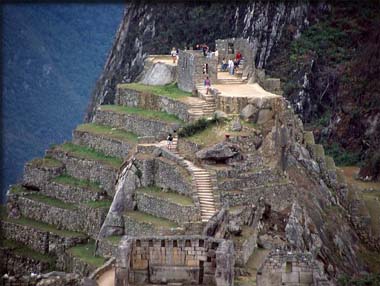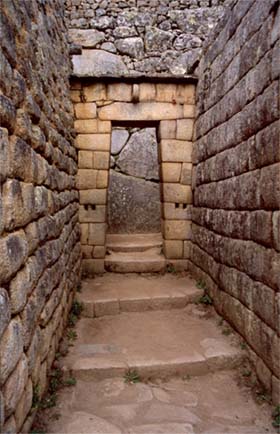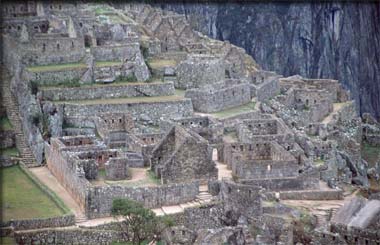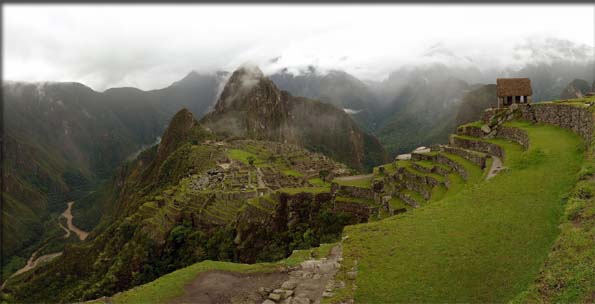Machu
Picchu: The Lost City
In 1911
American explorer Hiram Bingham set out to find the capital
of the long gone Incan Empire in Peru. With his expedition he
traveled down the Urubamba River asking local farmers about
ancient ruins. When he reached a place called Mandor Pampa,
Bingham, spoke an innkeeper named Melchor Arteaga. Arteaga told
Bingham he knew of an excellent set of ruins and led him up
a steep slope to an altitude of almost 8,000 feet. There, nestled
in a saddle between two peaks, Bingham found the ancient city
we now call Machu Picchu. According to the United Nations Educational,
Scientific and Cultural Organization the site is "an absolute
masterpiece of architecture and a unique testimony to the Inca
civilization."
|
Seven
Quick Facts
|
| Built:
Around 1450, at the height of the Inca Empire. |
| Purpose:
Estate of Inca Emperor Pachacuti |
| Location:
In Peru on top of a mountain at a height of 7,970 feet
(2,430 m). |
| Built
of: local stone and consists of numerous terraces
and about 200 buildings. |
| First
Excavated: In 1911 by explorer Hiram Bingham. |
| Abandoned:
Around 1572, but never discovered by Spanish Conquistadors.
|
| Other:
Often called "The List City of Incas" but this is a misnomer
as locals always were aware of the ruins. |
The
Inca Empire arose in the early 13th century in South America.
At its height it was the largest empire in America before the
arrival of Columbus encompassing much of modern Ecuador, parts
of Bolivia, northwest Argentina, sections of Chile and a small
portion of southern Colombia. Despite its size, the Incans achieved
this without many of the tools used by civilizations in the
rest of the world. Though they understood the principal, they
didn't use wheels for transportation, lacked draft animals to
pull wagons or plows, and didn't know how to make iron or steel.
In the
16th century the Empire was toppled by a combination of diseases
brought by European visitors and military conquest by the Spanish
which who wanted to exploit the silver and gold found in the
region. The Spanish raided many Incan cities and when they conquered
them, systematically destroyed much of Inca culture they found
there.
The
Spanish never found Machu Picchu, however. It was abandoned
at about the time of the conquest, but not because of military
action, but more likely because the dreaded disease, smallpox,
found its way to the remote mountain top and devastated the
population there.
|

This
view shows the of the western sector of the city and the
terraces surrounding the Intiwatana. (Courtesy
Colegota CC-BY-SA-2.5-ES)
|
The
name of the city in the language the Incans used (Quechuan)
is a combination of the word machu means "old" and picchu means
"peak" or "mountain" and can be translated as "old peak."
Construction
Archeologists
believe the city was built as an estate for the Inca emperor
Pachacuti who lived from 1438 AD to 1472 AD.. In constructing
it workers used what is now called the "classical Inca architectural
style:" polished dry-stone walls made with blocks cut to fit
together tightly without cement. To make the structures extra
sturdy because frequent earthquakes in the area, the builders
constructed the windows and doors in a trapezoidal shape which
resists damage from seismic tremors. On the corners they also
used "L" shaped blocks designed to tie the walls strongly together.
|

The
builders used trapaziod doors and windows to strengthen
against earthquakes. (Courtesy Colegota
CC-BY-SA-2.5-ES)
|
The
Southeast end of the city is known as the agriculture section.
The Incas constructed a series of terraces here that allowed
them to farm on the steep slopes of the mountain. The Northeast
section is more urban and is divided into an "upper" and "lower"
town. The upper town contained the temples and houses of the
nobility, while the lower town contained the warehouses and
dwellings of the common people.
The
Inca adapted their architecture carefully to the steep terrain
of the mountain. The city has a wide central square with the
approximately 200 buildings of the town arranged on wide parallel
terraces around it. Stairs cut into the terrace's stone walls
allow easy access to move from level to level. To handle the
heavy rainfall in the area the designers layered the terraces
with stone chips, sand, dirt and top soil, to absorb water and
keep it from streaming down the slopes, and then causing erosion
and landslides.
Some
of the more famous structures in the city include the Torreón,
a tower which may have been used as an observatory; the temple
of the sun and the Inti Watana, a ritual stone which
may have acted as an astronomic clock or calendar.
Excavation
Later
in his trip Bingham did discover the capital of the Incas, a
city called Vitcos. It was Machu Picchu that really captured
his attention, however, and in 1912 under the sponsorship of
Yale University and National Geographic he returned with an
expedition to take a closer look. He focused his research on
the city because of its excellent Inca stonework was well as
it well-preserved nature. Since it had been abandoned and never
found by the Spanish it was virtually undisturbed since the
last residents left it.
|

A
shot of the eastern residencial section of the city. (Courtesy
Colegota CC-BY-SA-2.5-ES)
|
Bingham
did much to bring the site to the attention of the world. While
initially the local authorities welcomed his work, later they
accused him of stealing precious artifacts. Though there is
no evidence that Bingham took anything illegally out of the
site, he did transport many legal artifacts to the Yale Museum.
The ownership of many of these remained a bone of contention
between Yale and the Peruvian authorities for many years. Eventually
the university and the government reached an agreement and the
last of the material excavated by Brigham was returned in 2011
and is housed at the National University of San Antonio Abad
del Cusco's La Casa Concha ("The Shell House") in the town of
Cusco.
Preservation
Concerns
The
city has become Peru's most visited tourist attraction and major
revenue generator with the number of visitors reaching 400,000
per year by the beginning of the 21st century. The large number
of visitors to the site and the economic opportunities presented
by it have been difficult to balance with the need to preserve
the site and keep visitors safe while visiting it.
In January
2010, a heavy rain caused flooding which washed away roads and
railways to Machu Picchu location. More than 2,000 locals and
another 2,000 tourists were trapped and had to be airlifted
out. The city was temporarily closed until April 1st while repairs
were made.
In an
attempt to preserve the site in July 2011 the authorities introduced
new entrance rules to the citadel of Machu Picchu limiting visitors
to 2,500 per day. Hopefully a balance between the public's desire
to see this unique historical treasure, and the need to protect
it for future generations can be found.
|

A
panoramic view of the city. (Courtesy of
Martin St-Amant - Wikipedia - CC-BY-SA-3.0)
|

Copyright Lee Krystek 2017. All Rights Reserved.